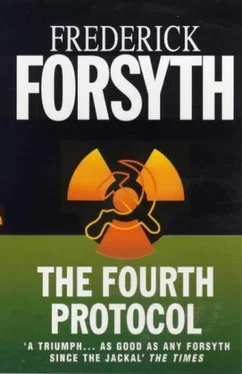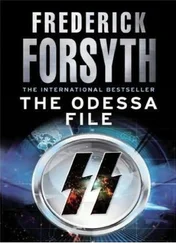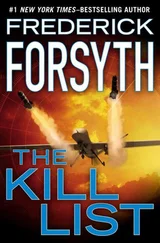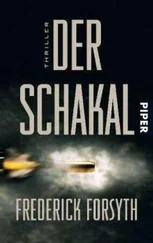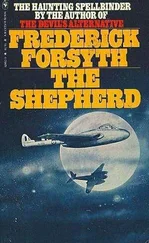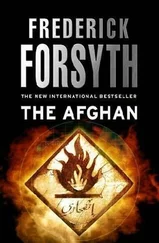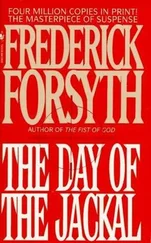Frederick Forsyth - The Fourth Protocol
Здесь есть возможность читать онлайн «Frederick Forsyth - The Fourth Protocol» весь текст электронной книги совершенно бесплатно (целиком полную версию без сокращений). В некоторых случаях можно слушать аудио, скачать через торрент в формате fb2 и присутствует краткое содержание. Жанр: Политический детектив, на английском языке. Описание произведения, (предисловие) а так же отзывы посетителей доступны на портале библиотеки ЛибКат.
- Название:The Fourth Protocol
- Автор:
- Жанр:
- Год:неизвестен
- ISBN:нет данных
- Рейтинг книги:3 / 5. Голосов: 1
-
Избранное:Добавить в избранное
- Отзывы:
-
Ваша оценка:
- 60
- 1
- 2
- 3
- 4
- 5
The Fourth Protocol: краткое содержание, описание и аннотация
Предлагаем к чтению аннотацию, описание, краткое содержание или предисловие (зависит от того, что написал сам автор книги «The Fourth Protocol»). Если вы не нашли необходимую информацию о книге — напишите в комментариях, мы постараемся отыскать её.
The Fourth Protocol — читать онлайн бесплатно полную книгу (весь текст) целиком
Ниже представлен текст книги, разбитый по страницам. Система сохранения места последней прочитанной страницы, позволяет с удобством читать онлайн бесплатно книгу «The Fourth Protocol», без необходимости каждый раз заново искать на чём Вы остановились. Поставьте закладку, и сможете в любой момент перейти на страницу, на которой закончили чтение.
Интервал:
Закладка:
After leaving school at sixteen, Rawlings had spent ten years working with and under his uncle Albert in the latter’s hardware shop. It was a good front for the old man, himself a notable safecracker in his day. It gave the eager young Rawlings access to every known lock on the market and to most of the smaller safes. After ten years of endless practice, and with Uncle Albert’s expert coaching, Rawlings could take just about any lock in manufacture.
From his trouser pocket he produced a ring of twelve skeleton keys, all made up in his own workshop. He selected and tested three, one after the other, and settled for the sixth on the ring. Inserting it into the Chubb, he began to detect the pressure points inside the lock. Then, using a flat pack of slim steel files from his top pocket, he started to work on the softer metal of the skeleton key. Within ten minutes he had the first two and a half levers—the configuration, or profile, that he needed. In another fifteen minutes he had reproduced the same lever pattern in reverse. Inserting the finished skeleton key into the Chubb lock, he turned it slowly and carefully.
It went fully back. He waited for sixty seconds, just in case Billy’s tamp of Plasticine and Super Glue had not held inside the doorjamb. No bells. He let out a sigh and went to work on the Yale with a fine steel spike. That took sixty seconds, and the door swung quietly open. It was dark inside, but the light from the corridor gave him the outlines of the empty hallway. It was about eight feet square and carpeted.
He suspected there would be a pressure pad under it somewhere, but not too close to the door, lest the owner trigger it himself. Stepping into the hall, close to the wall, he eased the door closed behind him and put on the hall light. To his left was a door, partly open, through which he could see a bathroom. To his right, another door, almost certainly the coat closet containing the alarm control system, which he would leave alone. Taking a pair of pliers from a breast pocket, he stooped and lifted an edge of the carpet. As the square of carpet rose, he spotted the pressure pad, in the dead center of the hall. Just the one. Letting the carpet fall gently back in place, he stepped around it and opened the larger door ahead of him. As Billy had said, it was the door to the sitting room.
He stood for several minutes on the threshold of the sitting room before identifying the light switch and putting on the lights. It was a risk, but he was eight floors above the street, the owners were in Yorkshire, and he did not have the time to work in a booby-trapped room by pencil flashlight.
The room was oblong, about twenty-five by eighteen feet, richly carpeted and furnished. Ahead of him were the double-glazed picture windows facing south and over the street. To his right was a wall containing a stone fireplace and, in one corner, a door that presumably led to the master bedroom suite. To his left the opposite wall contained two doors: one open to a hallway going to the guest bedrooms; the other closed, perhaps to the dining room and kitchen.
He spent another ten minutes standing motionless, scanning the walls and ceiling. His reason was simple: there could well be a static movement alarm that Billy Rice had not seen and that would detect any body heat or movement entering the room. If bells went off, he could be out of there in three seconds. There were no bells; the system was based on a wired-up door and, probably, windows, which he did not intend to touch anyway, and on a system of pressure pads on the floor.
The safe, he was sure, would be in this room or in the master bedroom, and it would be on an outside wall, since interior walls would not be thick enough. Just before eleven o’clock he spotted it. Right in front of him, in an eight-foot piece of wall between the two wide windows, was a gilt-framed mirror; it did not hang slightly away from the wall like the pictures, which cast narrow shadows at their edges, but was flat against the wall, as if hinged.
Using his pliers to lift the edge of the carpet, he worked his way around the walls, unveiling the threadlike wires leading from the baseboards to the pads, somewhere out toward the center of the room.
When he reached the mirror he saw there was one pressure pad directly beneath it. He thought of moving it, but instead lifted a large, low coffee table from nearby and placed it over the pad, its legs clear of the edges. He now knew that if he stayed close to the walls, or stood on pieces of furniture (no furniture can stand on a pressure pad), he would be safe.
The mirror was kept close to the wall by a magnetic catch, also wired. That was no problem. He slipped a flat wafer of magnetized steel between the two magnets of the catch, one in the mirror frame and the other in the wall. Keeping his substitute flat to the wall-based magnet, he eased the mirror away from the wall. The wall magnet made no protest; it was still touching another magnet, so it did not report that the contact had been broken.
Rawlings smiled. The wall safe was a nice little Hamber Model D. He knew the door was made of half-inch-thick high-tensile hardened steel; the hinge was a vertical rod of hardened steel, going into the frame upward and downward from the door itself. The securing mechanism consisted of three hardened-steel bolts emerging from the door and entering the frame to a depth of one and a half inches. Behind the steel face of the door was a two-inch-deep tinplate box containing the three locking bolts, the vertical control bolt that governed their movements, and the three-wheel combination lock whose face was now staring at him.
Rawlings did not intend to tamper with any of this. There was an easier way—to cut the door from top to bottom on the hinge side of the combination dial. That would leave sixty percent of the door, containing the combination lock and three locking bolts, jammed into the safe’s doorframe. The other forty percent of the door would swing open, giving him enough space to get his hand inside and the contents out.
He worked his way back to the hall, where he had left his bottle of champagne, and returned with it. Squatting on the coffee table, he unscrewed the bottom of the false bottle and emptied out his supplies. Apart from an electric detonator, ensconced in cotton in a small box, a collection of small magnets, and a reel of ordinary household electric cord, he had brought a length of CLC.
Rawlings knew the best way to cut half-inch steel plate was to use the Monroe theory, named after the inventor of the shaped-charge principle. What he was holding was called in the trade CLC, or charge-linear-cutting—a V-shaped length of metal, stiff but just pliable, encased in plastic explosive, manufactured by three companies in Britain, one government-owned and the other two in the private sector. CLC was definitely not available except under stringent license, but as a professional cracksman Rawlings had a contact, a “bent” employee in one of the private-sector companies.
Quickly and expertly. Rawlings prepared the length he needed and applied it to the outside of the Hamber’s door, from top to bottom, on just one side of the combination dial. Into one end of the CLC he inserted the detonator, from which protruded two twisted copper wires. These he untwisted and separated widely, to prevent a short circuit later. To each wire he attached one of the strands from his domestic electric cord, which itself terminated in a three-pin household plug.
Unraveling the cord carefully, he worked his way backward around the room and into the corridor leading to the guest bedrooms. The lee of the hallway would give him protection from the blast. Making his way gingerly to the kitchen, he filled with water a large polyethylene bag he took from his pocket. This he fixed to the wall with thumbtacks to hang over the explosive on the safe’s door. Feather cushions, Uncle Albert had told him, are for the birds and TV. There is no shock absorber like water.
Читать дальшеИнтервал:
Закладка:
Похожие книги на «The Fourth Protocol»
Представляем Вашему вниманию похожие книги на «The Fourth Protocol» списком для выбора. Мы отобрали схожую по названию и смыслу литературу в надежде предоставить читателям больше вариантов отыскать новые, интересные, ещё непрочитанные произведения.
Обсуждение, отзывы о книге «The Fourth Protocol» и просто собственные мнения читателей. Оставьте ваши комментарии, напишите, что Вы думаете о произведении, его смысле или главных героях. Укажите что конкретно понравилось, а что нет, и почему Вы так считаете.
